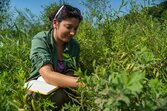2020 Annual Meeting - September 12, 2020
Due to the COVID-19 pandemic, our Annual Meeting this year was a Zoom Webinar.
We hope you all enjoyed the presentations. In case you missed it or want to see the presentations again, we recorded the program
Click Here to view.
Featured Speakers and Topics

Margaret Brittingham -Ph.D., Professor of Wildlife Resources, Extension Wildlife Specialist
Margaret is a Professor of Wildlife Resources in the Department of Ecosystem Science and Management at Penn State University where she teaches ornithology and is a Wildlife Extension Specialist for Pennsylvania. She has developed an extension fact sheet series on Landscaping for wildlife available at http://extension.psu.edu/natural-resources/wildlife/landscaping-for-wildlife
Landscaping for wildlife: Creating a backyard oasis – Are you ready to reduce the size of your lawn and attract native birds, butterflies and other wildlife to your yard? Native plants are the way to provide quality habitat no matter the size or location of your home space. This talk will cover the basics of wildlife habitat; how to landscape yards to provide food, cover, water and places to raise young; and will provide examples of some of the important and attractive native plants that provide the food and cover our native wildlife need.
Presented by
Margaret is a Professor of Wildlife Resources in the Department of Ecosystem Science and Management at Penn State University where she teaches ornithology and is a Wildlife Extension Specialist for Pennsylvania. She has developed an extension fact sheet series on Landscaping for wildlife available at http://extension.psu.edu/natural-resources/wildlife/landscaping-for-wildlife
Landscaping for wildlife: Creating a backyard oasis – Are you ready to reduce the size of your lawn and attract native birds, butterflies and other wildlife to your yard? Native plants are the way to provide quality habitat no matter the size or location of your home space. This talk will cover the basics of wildlife habitat; how to landscape yards to provide food, cover, water and places to raise young; and will provide examples of some of the important and attractive native plants that provide the food and cover our native wildlife need.
Presented by


